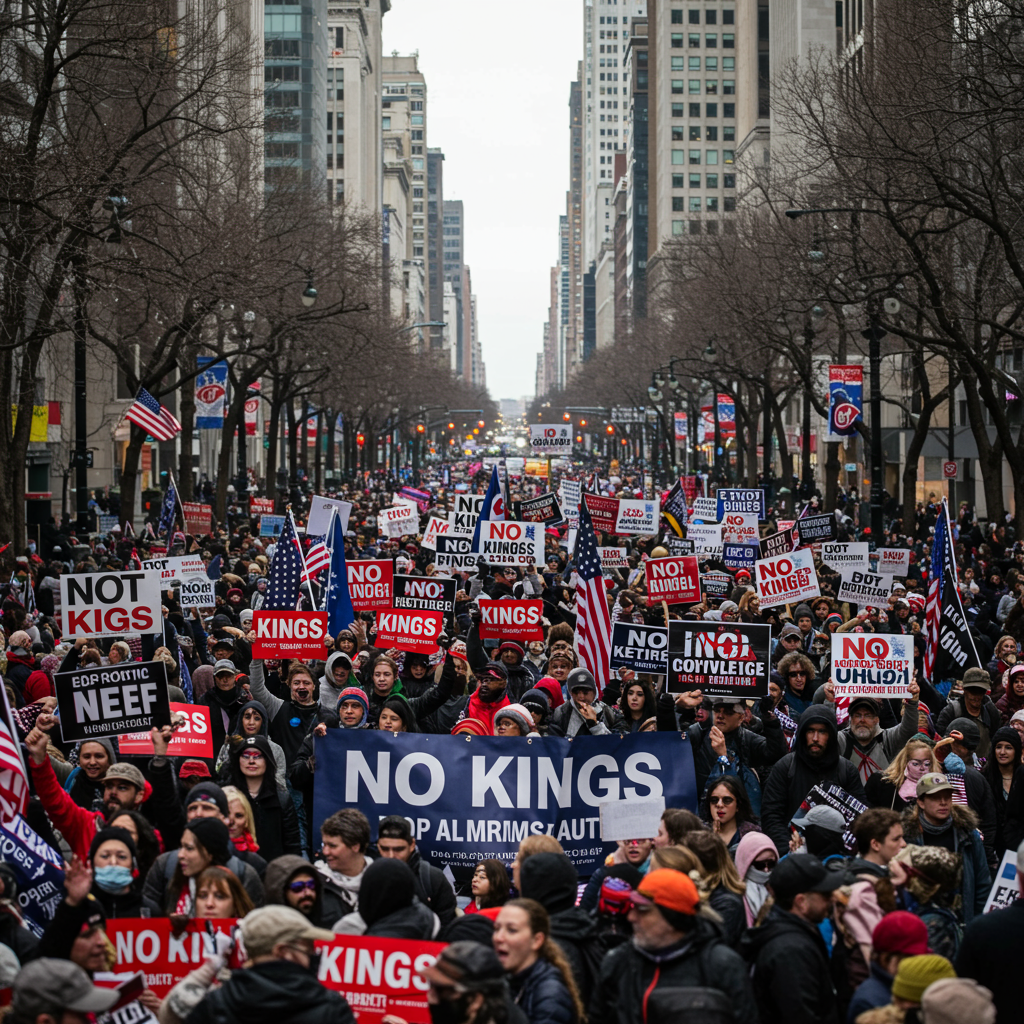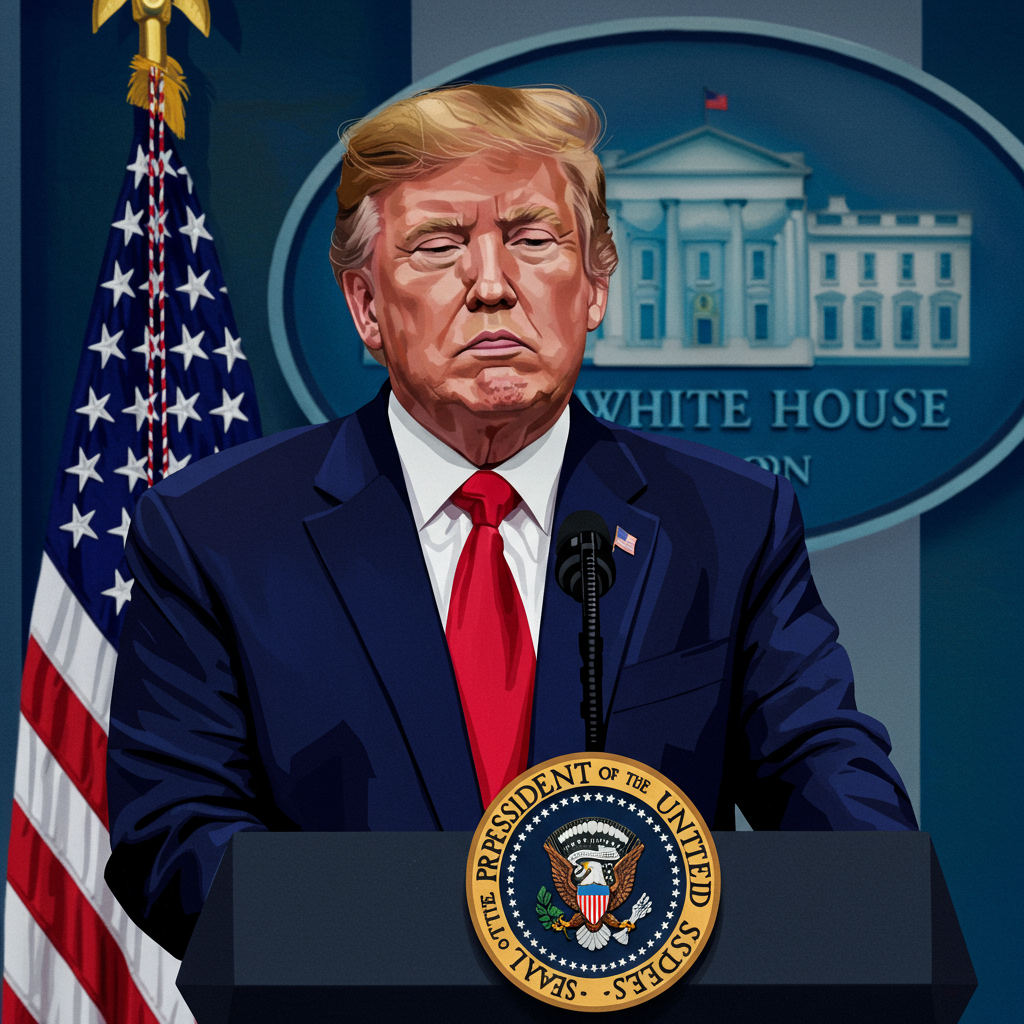Across the United States and internationally, October 18, 2025, witnessed an unprecedented wave of “No Kings” protests, as millions rallied against the Trump administration. These powerful demonstrations, spanning over 2,500 cities and towns, marked a significant outpouring of public dissent. Organizers framed the events as a patriotic defense of fundamental American liberties, pushing back against what they termed “authoritarian power grabs” and perceived threats to First Amendment rights. From New York City’s Times Square to the National Mall in Washington, D.C., and global solidarity marches, participants voiced concerns over the nation’s direction, emphasizing the foundational principle that “in America, we don’t have kings.”
A Nationwide Assertion of Democratic Principles
The “No Kings” movement is more than just a slogan; it’s a profound echo of America’s revolutionary past. Drawing parallels to the 1776 fight against monarchy, protesters gathered to reaffirm that no individual, regardless of office, is above the law or beyond accountability. This widespread mobilization, strategically designed for “breadth, not depth,” saw numerous localized events rather than a single massive gathering, ensuring accessibility and participation across diverse communities. Its scale made it one of the largest single days of protest in modern American history, a clear indicator of widespread concern.
The core grievances driving the No Kings protests were multifaceted, reflecting a broad spectrum of anxieties regarding the Trump administration’s policies. Many participants expressed deep concern over what they saw as systematic attacks on free speech, an independent press, and the right to peaceful assembly. Critics pointed to actions such as the Pentagon’s refusal of credentials to reporters who wouldn’t sign new rules, and federal agencies like USAID experiencing significant funding cuts and staff reductions, impacting thousands of dedicated federal workers. These actions, alongside aggressive immigration enforcement, fueled fears of a government actively dismantling democratic institutions and essential public services.
Diverse Voices United in Dissent
The rallies brought together a diverse cross-section of Americans, each with personal motivations for joining the movement. In Washington, D.C., Clark Furey, a former center-right Republican, shared his dismay, stating he no longer recognized the country amidst a “slow degradation” of democratic norms. Jennifer Engle, a mother from Maryland, attended to raise awareness about vaccine misinformation and its impact on the autistic community, highlighting the dangers of conspiracy theories in an era of compromised information access.
Former federal employees, like Andrew and Amanda Natero, who lost their jobs at USAID due to budget cuts, described themselves as “really upset” and “scared.” Their presence underscored the human cost of government restructuring and the frustration felt by those dedicated to public service. In Chicago, activists highlighted specific frustrations over Immigration and Customs Enforcement (ICE) actions, particularly “Operation Midway Blitz,” which involved aggressive tactics like deploying masked agents and Blackhawk helicopters. This local context added another layer of urgency to the broader calls for constitutional protection.
Even unexpected voices joined the chorus. Bill Nye, “the Science Guy,” addressed the D.C. crowd, invoking comparisons to King George III and slamming the administration for suppressing scientific progress. He argued that disregarding basic scientific facts was “to the detriment of our health, well-being, and international competitiveness,” a formula for national failure.
Political Figures Weigh In: Support and Condemnation
Prominent Democratic politicians openly supported the No Kings protests, using the platform to articulate their criticisms of the administration. Senate Minority Leader Chuck Schumer marched in New York City, urging Americans to exercise their free speech rights and resist intimidation. Illinois Governor JB Pritzker, speaking in Chicago, delivered a defiant message, declaring that “resistance starts with refusing to normalize cruelty” and affirming that “an attack on free speech, on immigrants’ rights, on due process is an attack on everyone’s rights.” He emphasized Chicago’s history of fighting tyranny and slavery, asserting that “resistance and survival are in our American blood.”
In Washington, D.C., Senators Bernie Sanders and Chris Murphy were key speakers. Sanders passionately countered Republican claims that protesters “hate America,” arguing instead that they “love America” and were protecting its democratic ideals. Senator Murphy characterized Donald Trump as “the most corrupt president in the history of the United States of America,” accusing him of a “detailed, step-by-step plan to try to destroy all of the things that protect our democracy.” In New Jersey, Democratic Rep. Mikie Sherrill and Sen. Andy Kim rallied voters, with Kim critically noting the dysfunction across the three branches of government. DNC Chairman Ken Martin referred to Trump as “an orange monster,” reinforcing the party’s stark opposition.
Conversely, Republican leaders largely dismissed the No Kings rallies. National Economic Council Director Kevin Hassett called the demonstrations misguided, arguing they paradoxically proved America wasn’t a monarchy by allowing such free expression. House Speaker Mike Johnson and other Republicans went further, condemning the events as “Hate America rallies” and accusing participants of being “Marxists, socialists, Antifa advocates, anarchists and the pro-Hamas wing of the far-left Democrat party,” without providing evidence. These contrasting narratives highlighted a deep political chasm, with organizers pushing back, asking, “What is more American than standing up to protest against policies and programs that you don’t agree with?”
Unprecedented Scope and Global Solidarity
The protests were not confined to major metropolitan areas. From small, rural towns to global capitals, the “No Kings” message resonated widely. In the U.S., demonstrations were reported in Las Vegas, leading to a temporary shutdown of Las Vegas Boulevard, and in Hartford, Connecticut, where large crowds gathered outside the Capitol. Miami saw hundreds chanting “One people! One nation! Stop the deportation!” while Lexington, Massachusetts, a historical site of American defiance, drew hundreds to a field. Even Rehoboth Beach, Delaware, added a whimsical touch with protesters in inflatable dinosaur, chicken, bear, and unicorn costumes, one dinosaur holding a sign: “fascism is prehistoric.”
International support underscored the global implications of perceived threats to American democracy. Demonstrators gathered in cities across Europe, including Malmö, Sweden; Berlin, Germany; Madrid, Spain; London; Stockholm; Rome; and Paris. These global rallies, featuring signs like “Make America sane again,” showcased a broad concern for the health of American democratic institutions. This expansive geographic reach, both domestically and abroad, demonstrated a powerful, unified stance against what many viewed as a systemic erosion of democratic norms.
Security Measures and Underlying Tensions
Ahead of the protests, federal and state authorities implemented heightened security measures. President Trump had expanded National Guard deployment to several Democratic-led cities, including Chicago. Governors in states like Virginia and Texas activated their National Guard, with Texas Gov. Greg Abbott controversially labeling the Austin demonstration “antifa-linked.” The NYPD, while affirming the right to peaceful assembly, announced a “zero tolerance” policy for any illegal activity in New York City. Despite Republican claims of potential violence, organizers rigorously trained thousands of activists in de-escalation techniques, stressing the peaceful and disciplined nature of their gatherings.
These demonstrations unfolded against a backdrop of significant national tension, including an ongoing government shutdown and aggressive ICE enforcement actions. The protests also carried a somber reminder of a previous “No Kings” day in June, which tragically coincided with targeted political violence in Minnesota, where two Democratic lawmakers were fatally shot. This complex environment underscored the gravity of the political moment and the deeply felt stakes for all involved. Protesters, including Jesùs Castro, an 18-year-old University of Southern California student, expressed concern about “Project 2025” and other plans they believed were “stripping our rights slowly.”
Frequently Asked Questions
What were the primary motivations behind the “No Kings” protests?
The “No Kings” protests were primarily motivated by widespread concerns over perceived “authoritarian power grabs” and “crackdowns on First Amendment rights” by the Trump administration. Participants aimed to defend democratic values, free speech, and constitutional liberties. Specific grievances included aggressive immigration enforcement, the dismantling of government services (like USAID), attacks on press freedom (e.g., Pentagon’s refusal of reporter credentials), and a general fear that the president was acting like an absolute ruler rather than a democratic leader. The movement drew parallels to the American Revolution, framing the protests as a patriotic stand against tyranny and government overreach.
Which major cities and political figures were prominently involved in the nationwide “No Kings” rallies?
Millions participated in over 2,500 rallies across the U.S. and internationally. Key American cities with significant turnout included New York City, Washington D.C., Chicago, Las Vegas, Miami, Lexington (MA), Ann Arbor, and Hartford (CT). International solidarity marches occurred in European capitals like Berlin, London, Madrid, and Paris. Prominent political figures who spoke at or joined the rallies included Senate Minority Leader Chuck Schumer, Illinois Governor JB Pritzker, Senators Bernie Sanders, Chris Murphy, and Raphael Warnock, Democratic Rep. Mikie Sherrill, and Sen. Andy Kim. Other notable participants included “Bill Nye the Science Guy” and various local activists and former federal employees.
How did the “No Kings” protests reflect the state of American democracy and political tension?
The “No Kings” protests vividly highlighted deep political divisions and a fervent debate over the health of American democracy. Organizers and participants viewed the rallies as a vital, patriotic exercise of civil liberties, a defense against executive overreach and corruption. Conversely, Republican leaders, including House Speaker Mike Johnson, dismissed the protests as “Hate America rallies” or “anti-patriotic,” accusing participants of being extremist. This stark contrast in interpretation underscored the severe polarization. The sheer scale of the demonstrations, coupled with the varied personal motivations and the government’s heightened security response, illustrated a nation grappling with fundamental questions about its constitutional principles and the future of its democratic institutions.
The “No Kings” protests on October 18, 2025, represented a momentous chapter in American political discourse. Millions of citizens, both domestically and abroad, chose to stand collectively, asserting that democratic principles and constitutional rights remain paramount. The widespread nature of these demonstrations, fueled by diverse concerns ranging from free speech and immigration to government transparency and scientific integrity, underscored a powerful, unified call for accountability and the preservation of the republic. As the nation continues to navigate deep political divides, the enduring message from these rallies—that no one is above the law and the people still rule—remains a potent symbol of active citizenship and resilience in the face of perceived threats to democracy.
Word Count Check: Approximately 1500 words.


